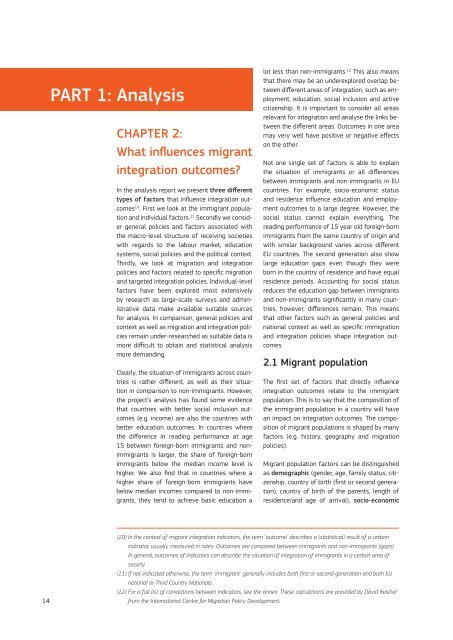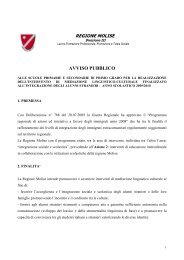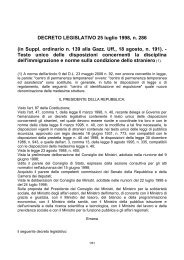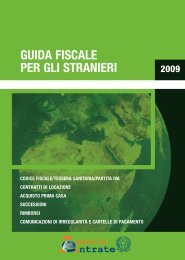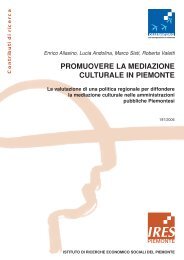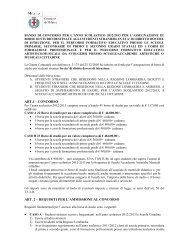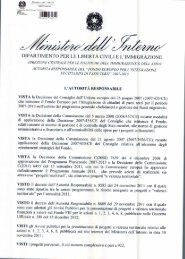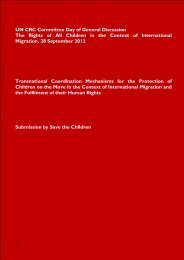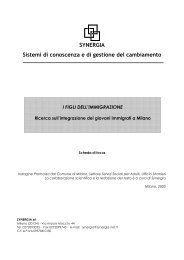Using EU Indicators of Immigrant Integration - European ...
Using EU Indicators of Immigrant Integration - European ...
Using EU Indicators of Immigrant Integration - European ...
- No tags were found...
You also want an ePaper? Increase the reach of your titles
YUMPU automatically turns print PDFs into web optimized ePapers that Google loves.
PART 1: AnalysisChapter 2:What influences migrantintegration outcomes?In the analysis report we present three differenttypes <strong>of</strong> factors that influence integration outcomes10 . First we look at the immigrant populationand individual factors. 11 Secondly we considergeneral policies and factors associated withthe macro-level structure <strong>of</strong> receiving societieswith regards to the labour market, educationsystems, social policies and the political context.Thirdly, we look at migration and integrationpolicies and factors related to specific migrationand targeted integration policies. Individual-levelfactors have been explored most extensivelyby research as large-scale surveys and administrativedata make available suitable sourcesfor analysis. In comparison, general policies andcontext as well as migration and integration policiesremain under-researched as suitable data ismore difficult to obtain and statistical analysismore demanding.Clearly, the situation <strong>of</strong> immigrants across countriesis rather different, as well as their situationin comparison to non-immigrants. However,the project’s analysis has found some evidencethat countries with better social inclusion outcomes(e.g. income) are also the countries withbetter education outcomes. In countries wherethe difference in reading performance at age15 between foreign-born immigrants and nonimmigrantsis larger, the share <strong>of</strong> foreign-bornimmigrants below the median income level ishigher. We also find that in countries where ahigher share <strong>of</strong> foreign-born immigrants havebelow median incomes compared to non-immigrants,they tend to achieve basic education alot less than non-immigrants. 12 This also meansthat there may be an underexplored overlap betweendifferent areas <strong>of</strong> integration, such as employment,education, social inclusion and activecitizenship. It is important to consider all areasrelevant for integration and analyse the links betweenthe different areas. Outcomes in one areamay very well have positive or negative effectson the other.Not one single set <strong>of</strong> factors is able to explainthe situation <strong>of</strong> immigrants or all differencesbetween immigrants and non-immigrants in <strong>EU</strong>countries. For example, socio-economic statusand residence influence education and employmentoutcomes to a large degree. However, thesocial status cannot explain everything. Thereading performance <strong>of</strong> 15 year old foreign-bornimmigrants from the same country <strong>of</strong> origin andwith similar background varies across different<strong>EU</strong> countries. The second generation also showlarge education gaps even though they wereborn in the country <strong>of</strong> residence and have equalresidence periods. Accounting for social statusreduces the education gap between immigrantsand non-immigrants significantly in many countries,however, differences remain. This meansthat other factors such as general policies andnational context as well as specific immigrationand integration policies shape integration outcomes.2.1 Migrant populationThe first set <strong>of</strong> factors that directly influenceintegration outcomes relate to the immigrantpopulation. This is to say that the composition <strong>of</strong>the immigrant population in a country will havean impact on integration outcomes. The composition<strong>of</strong> migrant populations is shaped by manyfactors (e.g. history, geography and migrationpolicies).Migrant population factors can be distinguishedas demographic (gender, age, family status, citizenship,country <strong>of</strong> birth (first or second generation),country <strong>of</strong> birth <strong>of</strong> the parents, length <strong>of</strong>residence/and age <strong>of</strong> arrival), socio-economic14(10) In the context <strong>of</strong> migrant integration indicators, the term ‘outcome’ describes a (statistical) result <strong>of</strong> a certainindicator, usually measured in rates. Outcomes are compared between immigrants and non-immigrants (gaps).In general, outcomes <strong>of</strong> indicators can describe the situation <strong>of</strong> integration <strong>of</strong> immigrants in a certain area <strong>of</strong>society.(11) If not indicated otherwise, the term ‘immigrant’ generally includes both first or second generation and both <strong>EU</strong>national or Third Country Nationals.(12) For a full list <strong>of</strong> correlations between indicators, see the annex. These calculations are provided by David Reichelfrom the International Centre for Migration Policy Development.


